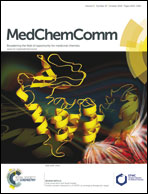N-Arylalkylbenzo[d]thiazole-2-carboxamides as anti-mycobacterial agents: design, new methods of synthesis and biological evaluation†
Abstract
Benzothiazole-2-carboxyarylalkylamides are reported as a new class of potent anti-mycobacterial agents. Forty-one target compounds have been synthesized following a green synthetic strategy using water as the reaction medium to construct the benzothiazole scaffold followed by (i) microwave-assisted catalyst-free and (ii) ammonium chloride-catalyzed solvent-free amide coupling. The anti-mycobacterial potency of the compounds was determined against H37Rv strain. Twelve compounds exhibited promising anti-TB activity in the range of 0.78–6.25 μg mL−1 and were found to be non-toxic (<50% inhibition at 50 μg mL−1) to HEK 293T cell lines with therapeutic index (TI) of 8–64. The most promising anti-TB compound 5bf showed MIC of 0.78 μg mL−1 (TI > 64). The molecular docking studies of 5bf predict it to be a ligand for the M. tuberculosis HisG, the putative drug target for tuberculosis and could serve as a guiding principle for lead optimization.
![Graphical abstract: N-Arylalkylbenzo[d]thiazole-2-carboxamides as anti-mycobacterial agents: design, new methods of synthesis and biological evaluation](/en/Image/Get?imageInfo.ImageType=GA&imageInfo.ImageIdentifier.ManuscriptID=C4MD00224E&imageInfo.ImageIdentifier.Year=2014)

 Please wait while we load your content...
Please wait while we load your content...